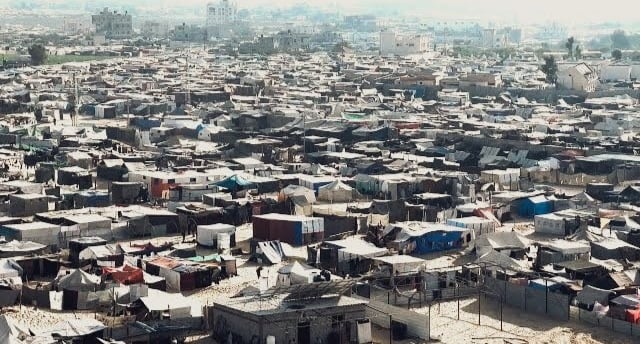Al-Mawasi, Khan Younis: An Open-Air Prison Suffocating with Displaced Lives
A harrowing humanitarian report from southern Gaza unveils the unfolding catastrophe in Al-Mawasi, where over 700,000 displaced Palestinians are trapped in dire conditions amid relentless Israeli bombardment, infrastructure collapse, and mounting health crises.
NEWSREPORT
Refaat Ibrahim
6/22/20253 min read


At the heart of the Gaza Strip, one of the gravest humanitarian catastrophes is unfolding in Al-Mawasi, a narrow coastal stretch in southern Gaza. Once a peaceful agricultural area, Al-Mawasi has been forcibly transformed into a massive refuge for hundreds of thousands of displaced Palestinians. These families, uprooted from their homes in Rafah and Khan Younis by relentless Israeli bombardment and repeated evacuation orders, now endure conditions of unthinkable hardship, stripped of the most basic necessities of life and dignity.
This report aims to shed light on the crisis in Al-Mawasi, exploring its multiple dimensions and the devastating impact it has had on the lives of civilians, particularly women, children, and the elderly.
Repeated Displacement and a Fully-Fledged Humanitarian Crisis
Overcrowding and Psychological Collapse
Following the intensification of Israeli military operations in Gaza, Al-Mawasi has become a forced destination for tens of thousands of displaced families from Rafah, Khan Younis, and other areas. The zone, just 12 square kilometers in size, is in no way equipped to host this immense population. Many now sleep in makeshift tents or simply on dirt and pavement amid extreme shortages of food, clean water, and medicine.
The crisis deepened when evacuation orders extended even to areas in western Khan Younis previously considered “relatively safe.” Every family in Al-Mawasi carries a story of a third or fourth displacement. Every child born under canvas is a living witness to the world’s failure to uphold its humanity. Children now suffer from severe trauma; the elderly are especially vulnerable due to harsh weather, disease, and the absence of medical care.
Israeli strikes persist daily, often targeting the very tents where families seek shelter. Local reports confirm thousands of casualties, primarily women and children, adding urgency to what many describe as a “slow, collective strangulation.” The machinery of war, paired with global silence, continues to escalate the suffering.
Multiple Crises Threatening Lives
In addition to airstrikes and displacement, the people of Al-Mawasi face looming environmental and health hazards. Roughly 250,000 tons of waste now pile up in makeshift dumps, most notably in the Al-Amal neighborhood, posing major public health threats. Outbreaks of deadly disease are a daily risk due to the lack of sanitation and access to clean water.
The Emergency Committee of Khan Younis municipality stated that Israel’s ban on fuel entry has halted the operation of water pumps and waste collection, compounding the crisis. Of the 45 wells that once served the governorate, only five remain operational, and even those function at limited capacity. The destruction of four underground water reservoirs has left the population reliant on water tankers or small, local wells, neither of which is sufficient or safe.
Systematic Destruction and a Strategy of Depopulation
Wrecked Infrastructure and a Devastated Breadbasket
The Israeli military campaign has gone far beyond targeting civilians; it has methodically destroyed the infrastructure of Khan Younis. From December 2023 to April 2024, Israeli forces overran the area, reducing entire towns like Khuza’a, New Abasan, and Al-Qarara, previously vital agricultural hubs, into rubble. In some localities, the destruction rate has reached 100%, leaving residents with nothing to return to.
Within the 54 square kilometers under Khan Younis municipality’s jurisdiction, the destruction has encompassed
300 km of water networks
80% of sewage infrastructure
120 km of paved roads
Seven out of nine sewage stations
Twenty out of twenty-six essential municipal service vehicles
This widespread devastation has paralyzed the region’s seven municipalities, especially since most areas are now classified by the Israeli military as “high-risk combat zones.”
Buffer Zone Plans and Forced Displacement
According to local officials, including Dr. Ismail Al-Thawabta, Director of the Government Media Office, the events in Khan Younis and Al-Mawasi are part of a broader Israeli strategy aimed at forced depopulation. This plan, often referred to as the “buffer zone,” seeks to carve out sections of southern Gaza and permanently alter the area’s demographic and geographic realities.
Al-Mawasi now holds around 890 displacement camps, with some 78,000 tents, none of which meet minimum living standards. These camps arose after the destruction of over 92% of homes and civilian infrastructure in the governorate. Unsanitary and overcrowded, they have become breeding grounds for disease. Al-Thawabta argues that Israel uses Khan Younis, due to its strategic location and dense population, as a testing ground for total deterrence, inflicting collective punishment to send a warning to the rest of Gaza.
Conclusion: A Call for Urgent International Action
What is unfolding in Al-Mawasi is not just a humanitarian crisis; it is an ongoing crime that demands immediate international intervention. The overwhelming population density, extreme shortages, public health collapse, and continued bombardment make every day without action a further crime against civilians.
The United Nations and global humanitarian organizations must act now, opening safe aid corridors, ensuring access to fuel, medicine, and water, and halting all forms of forced displacement.
Al-Mawasi today is more than just a place. It is a symbol of the Palestinian people’s endurance in the face of death and neglect and a stark test for the world's moral compass.
The pressing question remains: How long will the world remain silent in the face of this slow suffocation?
Saving the lives of hundreds of thousands in Al-Mawasi is not only a humanitarian duty, it is a litmus test of whether the international community still upholds the values of justice, dignity, and human rights.
Awareness
Documenting reality, amplifying Palestinian voices, raising awareness.
Contact Us:
resistant.p.pens@gmail.com
Follow our social media
